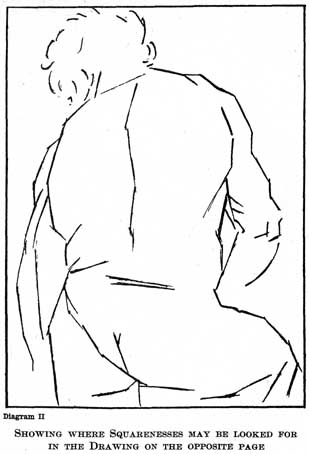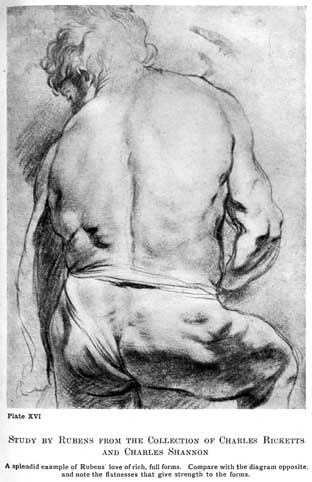we have seen that there are two extreme points of view from which the representation of form can be approached, that of outline directly related to the mental idea of form with its touch association on the one hand, and that of mass connected directly with the visual picture on the retina on the other.
now, between these two extreme points of view there are an infinite variety of styles combining them both and leaning more to the one side or the other, as the case may be. but it is advisable for the student to study both separately, for there are different things to be learnt and different expressive qualities in nature to be studied in both.
from the study of outline drawing the eye is trained to accurate observation and learns the expressive value of a line. and the hand is also trained to definite statement, the student being led on by degrees from simple outlines to approach the full realisation of form in all the complexity of light and shade.
but at the same time he should study mass drawing with paint from the purely visual point of view, in order to be introduced to the important study of tone values and the expression of form by means of planes. and so by degrees he will 81learn accurately to observe and portray the tone masses (their shapes and values) to which all visual appearances can be reduced; and he will gradually arrive at the full realisation of form—a realisation that will bring him to a point somewhat similar to that arrived at from the opposite point of view of an outline to which has been added light and shade, &c.
but unless both points of view are studied, the student's work will be incomplete. if form be studied only from the outline point of view, and what have been called sculptor's drawings alone attempted, the student will lack knowledge of the tone and atmosphere that always envelop form in nature. and also he will be poorly equipped when he comes to exchange the pencil for a brush and endeavours to express himself in paint.
and if his studies be only from the mass point of view, the training of his eye to the accurate observation of all the subtleties of contours and the construction of form will be neglected. and he will not understand the mental form stimulus that the direction and swing of a brush stroke can give. these and many things connected with expression can best be studied in line work.
let the student therefore begin on the principles adopted in most schools, with outline studies of simple casts or models, and gradually add light and shade. when he has acquired more proficiency he may approach drawing from the life. this is sufficiently well done in the numerous schools of art that now exist all over the country. but, at the same time (and this, as far as i know, is not done anywhere), the student should begin some simple form of mass drawing in paint, simple exercises, 83as is explained later in the chapter on mass drawing, practical, being at first attempted and criticised solely from the point of view of tone values.

diagram ii.
showing where squarenesses may be looked for in the drawing on the opposite page

plate xvi.
study by rubens from the collection of charles ricketts and charles shannon
a splendid example of rubens' love of rich, full forms. compare with the diagram opposite, and note the flatnesses that give strength to the forms.
from lack of this elementary tone study, the student, when he approaches painting for the first time, with only his outline and light and shade knowledge, is entirely at sea. with brushes and paint he is presented with a problem of form expressions entirely new. and he usually begins to flounder about, using his paint as much like chalk on paper as possible. and timid of losing his outlines, he fears to put down a mass, as he has no knowledge of reducing appearances to a structure of tone masses or planes.
i would suggest, therefore, that the student should study simultaneously from these two points of view, beginning with their most extreme positions, that is, bare outline on the one side and on the other side tone masses criticised for their accuracy of values only in the first instance. as he advances, the one study will help the other. the line work will help the accuracy with which he observes the shapes of masses, and when he comes to light and shade his knowledge of tone values will help him here. united at last, when complete light and shade has been added to his outline drawings and to his mass drawing an intimate knowledge of form, the results will approximate and the two paths will meet. but if the qualities appertaining to either point of view are not studied separately, the result is confusion and the "muddling through" method so common in our schools of art.
